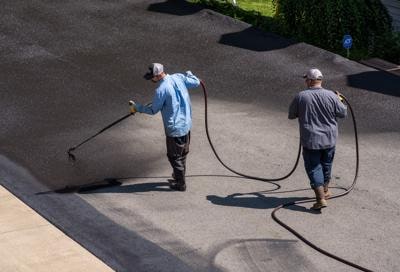Cold Mix Asphalt Vs. Hot Mix Asphalt: Which Is Right for You?

Structure Distinctions
Cold mix asphalt is created by emulsifying the asphalt binder with water and an emulsifying representative prior to blending it with aggregate. The warm mix asphalt manufacturing procedure involves heating up the aggregate and asphalt binder individually before incorporating them at the asphalt plant.
Additionally, chilly mix asphalt has a tendency to be less dense and extra flexible than hot mix asphalt. This flexibility makes it better matched for locations with greater degrees of motion, such as driveways or roads with heavy website traffic. In comparison, warm mix asphalt is understood for its high sturdiness and resistance to rutting and splitting, making it a preferred selection for freeways and high-traffic roads where longevity is vital.
Installment Process Variations
The procedure of setting up cool mix and warm mix asphalt exhibits significant differences in their procedures and demands. In contrast, hot mix asphalt demands an extra fancy setup process. Due to the home heating needs, hot mix asphalt installations are normally carried out by specialists with specialized equipment, making certain a more long-term and structurally audio result.
Toughness and Long Life Factors
When taking into consideration asphalt choices, sturdiness and durability are vital aspects to assess for long-term sidewalk efficiency,. Hot mix asphalt (HMA) is understood for its remarkable toughness and long life. The high temperature levels during the mixing and laying process permit for far better compaction, causing a denser and more powerful sidewalk framework. This results in HMA being much more resistant to hefty website traffic tons, severe climate condition, and the impacts old compared to cold mix asphalt (CMA)
In regards to durability, HMA typically exceeds CMA because of its exceptional toughness and resistance homes. HMA pavements have a longer solution life, requiring less constant repair services and maintenance, which can equate to set you back savings in the long run. Furthermore, HMA pavements are a lot more conveniently adjustable to meet details project requirements, even more enhancing their longevity.
Expense Factors To Consider
Considering the monetary implications is a vital aspect when reviewing the choice in between warm mix asphalt (HMA) and chilly mix asphalt (CMA) for pavement tasks. While the preliminary price of warm mix asphalt is typically greater than that of cold mix asphalt, HMA typically gives a more cost-effective option in the future due to its remarkable longevity and durability. HMA is recognized for its ability to endure heavy web traffic lots and harsh weather condition problems, lowering the demand for frequent repair work and upkeep. On the various other hand, chilly mix asphalt is more budget friendly upfront however may need even more constant patching and resurfacing, bring about greater upkeep expenses gradually.
Along with material prices, it's important to consider the expenses linked with setup and maintenance when comparing HMA and CMA. HMA generally calls for specific equipment and skilled labor for correct setup, which can impact total job costs. Alternatively, CMA is less complicated to collaborate with and can often be used using simpler methods, potentially reducing installation expenditures. Eventually, the choice in between HMA and CMA need to take into consideration not just the first cost however also the lasting financial effects to identify one of the most economical option for the certain pavement job.
Environmental Effect Contrast
Contrast of the ecological influences in between warm mix asphalt (HMA) and cool mix asphalt (CMA) discloses distinctive distinctions in sustainability methods. HMA manufacturing calls for high temperature levels, leading to boosted power consumption and greenhouse gas emissions.
In addition, the usage of CMA usually includes recycling existing asphalt sidewalk, advertising resource conservation and lowering the amount of waste sent out to land fills. By choosing for navigate to this website CMA over HMA, roadway building projects can contribute positively to ecological conservation efforts.
Conclusion
To conclude, the option in between cold mix asphalt (CMA) and warm mix asphalt (HMA) depends upon numerous factors such as structure, installment procedure, longevity, longevity, expense, and ecological influence. cold mix asphalt. While CMA supplies a economical and fast remedy for minor repair services, HMA makes certain superior sturdiness and long life for rush hour locations. Take into consideration these elements meticulously to identify which kind of asphalt is the right option for your paving requires

Taking into consideration the financial ramifications check my blog is an important aspect when assessing the selection between hot mix asphalt (HMA) and chilly mix asphalt (CMA) for pavement projects. While the preliminary expense of warm mix asphalt is generally higher than that of chilly mix asphalt, HMA often offers a much more cost-efficient solution in try this out the lengthy run due to its premium resilience and durability. asphalt repair.Comparison of the ecological impacts between hot mix asphalt (HMA) and chilly mix asphalt (CMA) exposes distinctive distinctions in sustainability practices.In final thought, the option between chilly mix asphalt (CMA) and warm mix asphalt (HMA) depends on numerous factors such as composition, installation process, sturdiness, long life, expense, and ecological influence